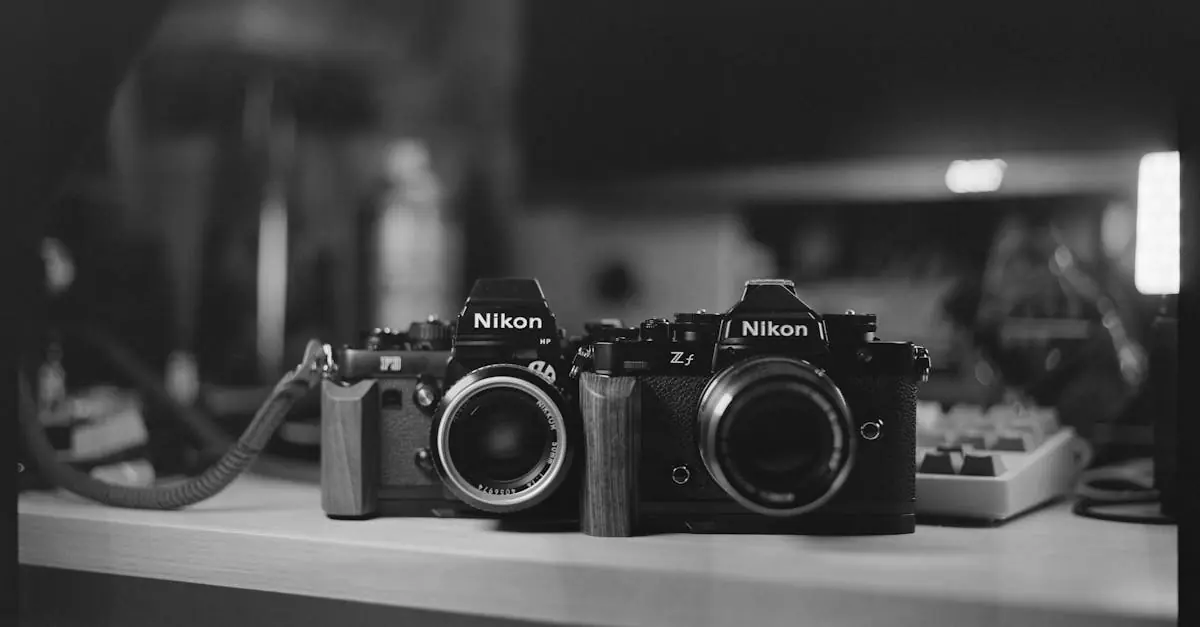In a world where everyone’s a photographer, choosing the right mirrorless camera can feel like trying to pick a favorite child—impossible! With sleek designs and impressive tech, these cameras promise to elevate anyone’s photography game. But how do you know which one’s worth the investment?
Table of Contents
ToggleOverview Of Mirrorless Cameras
Mirrorless cameras represent a significant advancement in photography technology. These cameras utilize electronic viewfinders and image sensors instead of mirrors and optical viewfinders found in traditional DSLR cameras. A compact design distinguishes mirrorless models, making them lightweight and easy to carry.
Enhanced performance characterizes these cameras. They often feature faster autofocus systems, enabling quick subject tracking. Additionally, continuous shooting speeds typically reach 10 frames per second or more, allowing photographers to capture fast-moving subjects with clarity.
Variability in lens options exists for mirrorless cameras. Manufacturers offer a wide range of lenses, including prime, zoom, and specialty options, catering to different photography styles and preferences. Full-frame sensor models provide improved low-light performance and dynamic range, appealing to enthusiasts and professionals alike.
Battery life is another consideration. Although mirrorless cameras may have shorter battery lives compared to DSLRs, advancements are continually made. Some models now support dual battery systems, extending shooting sessions significantly.
User-friendly interfaces enhance the overall experience. Many models feature touchscreen displays, enabling intuitive navigation through menus and settings. Customizable buttons allow users to tailor their camera settings for quick access during shoots.
Affordability also varies extensively. Entry-level models cater to hobbyists with budget-friendly options, while high-end models attract professionals looking for exceptional image quality and advanced features. The selection continues to grow, providing numerous choices for various skill levels and budgets.
Key Features To Consider
Selecting the right mirrorless camera involves evaluating several key features that directly impact performance and usability.
Sensor Size
Sensor size affects image quality and performance in low light. Larger sensors, like full-frame types, capture more light, resulting in improved detail and reduced noise. Many photographers prefer larger sensors for landscape or portrait photography. Crop sensors, while smaller, are lighter and more affordable. They may provide a greater depth of field, which can be beneficial for certain styles, especially macro or wildlife photography. Consider how sensor size aligns with specific photography needs to ensure the best results.
Autofocus System
Autofocus systems play a crucial role in capturing sharp images, especially with moving subjects. Many mirrorless cameras use phase-detection or contrast-detection systems. Phase-detection provides quicker and more accurate focusing, ideal for fast-paced environments. Contrast-detection, while slower, delivers precise focus under controlled lighting conditions. Various cameras now feature advancements like eye-detection autofocus, enhancing portrait photography. Evaluating the autofocus capabilities helps ensure successful focus in diverse shooting situations.
Image Stabilization
Image stabilization helps reduce blur from camera shake, significantly benefiting handheld shooting. Many mirrorless cameras incorporate in-body stabilization, allowing for smoother video and sharper photos. This technology compensates for minor movements during shooting. Lens-based stabilization may also be available, complementing the in-body system for enhanced effectiveness. Photographers shooting in low light or at longer focal lengths find this feature invaluable. Prioritizing image stabilization ensures crisp images across various conditions and settings.
Popular Mirrorless Camera Models
Several models stand out in the mirrorless camera market, each offering unique features and capabilities tailored to different users.
Model A Review
The Sony Alpha a7 III features a full-frame sensor that excels in low-light environments. Autofocus capabilities include 693 phase-detection points, ensuring precise and quick focusing on moving subjects. Continuous shooting speeds reach up to 10 frames per second, accommodating dynamic photography styles. Battery life impresses with approximately 710 shots, making long shooting sessions feasible. Additionally, its 4K video recording provides filmmakers with high-quality footage.
Model B Review
The Canon EOS R6 presents photographers with a versatile full-frame option. Its advanced Dual Pixel autofocus system boasts 1,053 AF points, creating rapid and accurate focus on subjects. Continuous shooting speeds of 20 frames per second enhance action photography. In low-light conditions, ISO performance impresses, achieving clean images up to 102,400. A vari-angle touchscreen LCD supports creative shooting angles and intuitive navigation, enhancing the user experience.
Model C Review
Fujifilm X-T4 combines retro design with modern technology. Featuring a crop sensor, it strikes a balance between portability and image quality. 5-axis in-body image stabilization reduces motion blur for handheld shooting, proving helpful in various conditions. Fast autofocus capabilities include eye-detection, ideal for portrait photography. With 4K video up to 60 frames per second, it caters to both stills and video creators. Its film simulation modes offer diverse options for creative expression.
Comparison Of Specifications
A side-by-side comparison of key specifications reveals how different mirrorless camera models cater to various needs. Sensor size impacts image quality significantly. Larger full-frame sensors, like those in the Sony Alpha a7 III and Canon EOS R6, excel in low-light performance, providing clearer images. For photographers seeking portability, crop sensors, as seen in the Fujifilm X-T4, balance weight and cost effectively.
Autofocus systems demonstrate variation in performance. The fast phase-detection technology found in the Sony Alpha a7 III ensures quick focusing on moving subjects. Eye-detection, a feature in models like the Canon EOS R6, enhances portrait photography by locking onto the subject’s eyes with precision.
Image stabilization plays a crucial role for handheld shooting. The in-body stabilization in the Fujifilm X-T4 minimizes blur, making it ideal for a range of shooting scenarios. Dual battery systems, especially in newer models, address battery life concerns, allowing extended shooting sessions without frequent recharging.
Continuous shooting speed varies among models. The Canon EOS R6 offers impressive capabilities, enabling photographers to capture fast-moving activities effectively. Users benefit from responsive touchscreen displays and customizable buttons, making camera operation intuitive and efficient across different brands.
Connecting lenses adds versatility. Each camera features compatible lenses tailored for various photography styles. Full-frame models often support a wider selection of high-quality lenses, while crop sensor cameras may offer lighter and more affordable options for hobbyists.
Analyzing these specifications aids in selecting the perfect mirrorless camera that aligns with individual photography needs and preferences.
Real-World Performance
Real-world performance of mirrorless cameras showcases their strengths in critical photography areas. Evaluating low-light capabilities and video quality reveals their versatility.
Low-Light Capabilities
Low-light performance significantly varies among mirrorless cameras. Larger full-frame sensors, like those in the Sony Alpha a7 III and Canon EOS R6, produce excellent image quality and reduce noise in dim conditions. Faster maximum apertures in compatible lenses enhance performance further, allowing photographers to capture clearer images without flash. Crop sensor models may struggle in low-light settings, but advancements in noise reduction technology improve their capabilities. For nighttime shoots or indoor events, opting for a full-frame camera proves advantageous for achieving vibrant results.
Video Quality
Video quality often distinguishes mirrorless cameras from traditional DSLRs. Models such as the Fujifilm X-T4 provide 4K recording at 60 frames per second, ensuring smooth motion and detailed imagery. Advanced autofocus systems also maintain sharp focus during video capture, appealing to those creating dynamic content. Color profiles, including options for cinema-like finishes, enhance creative freedom for filmmakers. Dual recording formats allow for flexibility in post-production. Additionally, in-body image stabilization significantly reduces camera shake in handheld shooting, essential for achieving professional-looking video.
Conclusion
Choosing the right mirrorless camera can significantly impact a photographer’s journey. With a variety of models available that cater to different styles and budgets, it’s essential to assess personal needs and preferences. Factors like sensor size autofocus capabilities and image stabilization play crucial roles in overall performance.
By focusing on these key features photographers can make informed decisions that enhance their skills and creativity. Whether capturing stunning landscapes or fast-paced action shots mirrorless cameras offer the tools needed to elevate photography to the next level. Investing in the right model ensures a rewarding experience that meets both artistic and practical demands.





